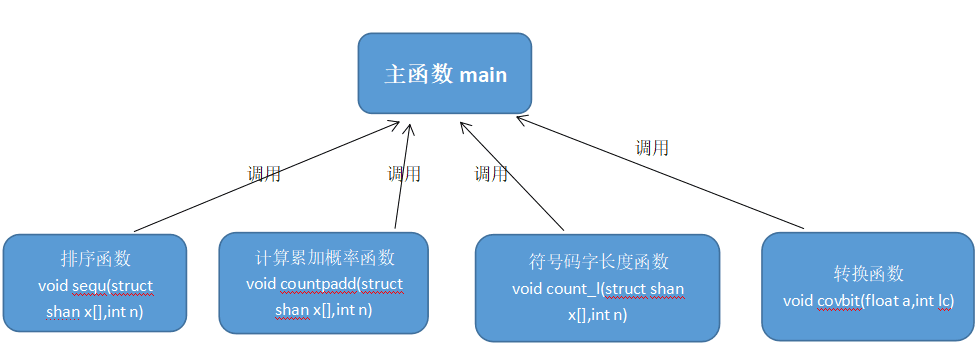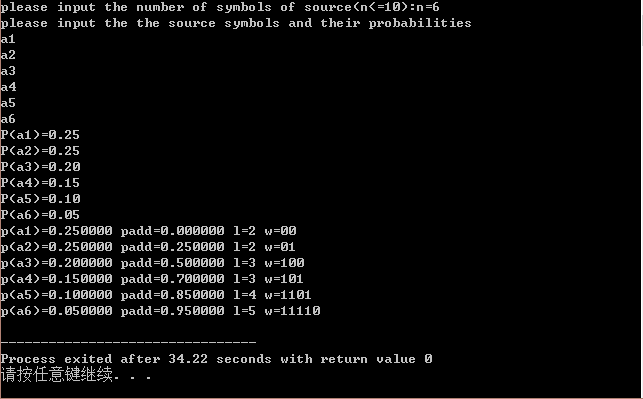1、设计思想
为了设计的方便,我们需要在这个程序里设计一个结构体,以用来存储信源符号、信源符号概率等参数,将每一组参数看成一个结构体来看待,这样我们就可以随时地调用。
2、设计流程
主函数部分,我们先接收要输入的信源符号个数,再接收每个信源符号的名称以及他的概率。
主函数设计好后,我们将各功能的函数分成几个模块来写,第一个是排序函数,如果你坚持从大到小输入则可以不用写;第二个函数计算前几个符号概率的累加;第三个函数计算每个符号码字长度;第四个函数将累加概率转换为二进制。各个函数分工完成的话,问题就变得简单多了。
我们来简单绘制一下其流程图:
扫描二维码关注公众号,回复:
148641 查看本文章


3、设计程序
#include <stdio.h>
#include <math.h>
#include <string.h>
int i,j,n,k,b;
float a;
char bitw[20];
struct shan
{
char s[20];
float p;
float pa;
float l_f;
int l;
char w[20];
}data[12];
void sequ(struct shan x[],int n)
{
struct shan temp;
for(i=0;i<n;i++)
for(j=i;j<n;j++)
{
if(x[i].p<x[j].p)
{
temp=x[j];
x[j]=x[i];
x[i]=temp;
}
}
}
void countpa(struct shan x[],int n)
{
a=0;
x[0].pa=0;
for(i=0;i<n;i++)
{
a+=x[i].p;
x[i+1].pa=a;
}
}
void count_l(struct shan x[],int n)
{
for(i=0;i<n;i++)
{
x[i].l_f=-log(x[i].p)/log(2);
if((x[i].l_f-(int)x[i].l_f)>0)
{
x[i].l=(int)x[i].l_f+1;
}
else x[i].l=(int)x[i].l_f;
}
}
void covbit(float d,int lc)
{
for(j=0;j<lc;j++)
{
b=(int)(d*2);
bitw[j]=b+48;
d=2*d-int(d*2);
}
}
main()
{
printf("please input the number of symbols of source(n<=10):n=");
scanf("%d",&n);
printf("please input the the source symbols and their probabilities\n");
for(i=0;i<n;i++)
{
scanf("%s",data[i].s);
}
for(i=0;i<n;i++)
{
printf("P(%s)=",data[i].s);
scanf("%f",&data[i].p);
}
sequ(data,n);
countpa(data,n);
count_l(data,n);
for(i=0;i<n;i++)
{
covbit(data[i].pa,data[i].l);
strcpy(data[i].w,bitw);
}
for(i=0;i<n;i++)
printf("p(%s)=%f padd=%f l=%d w=%s\n",data[i].s,data[i].p,data[i].pa,data[i].l,data[i].w);
}
4、设计结果
参考:https://blog.csdn.net/keyhn/article/details/5185806

